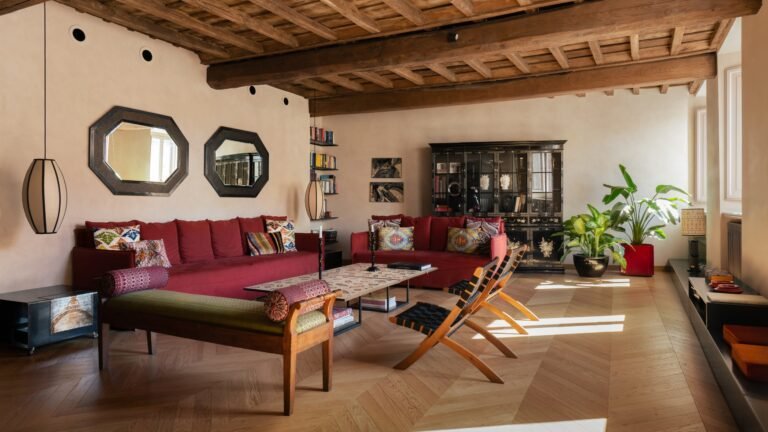In Material Reform, Material Cultures rethinks the cultures, systems, and infrastructures of how we make architecture
Material Cultures is a London-based not-for-profit organization led by Summer Islam, Paloma Gormley and George Massoud, which investigates and advocates for the use of bio-based materials in the built environment. Bio-based materials are low in embodied carbon and offer an alternative to the globally sourced, carbon-intensive, socially destructive materials commonly used in the construction industry.
In Material Reform: Building for a Post-Carbon Future, the practice presents a series of short essays on topics concerning labor, time, maintenance, language, land, and touch in architecture. The authors take a close look at architecture’s cultures, systems, and infrastructures that enable its role in destructive ecologies. While the practice is focused on the particular conditions of the U.K., its lessons are valuable for readers everywhere. The book argues that exploitation and degradation are embedded in building practices proliferated by contemporary architecture. Material Cultures offers the exploration low-carbon, local materials as a productive way forward to reduce the environmental impacts of buildings.

The book, published by MACK, is coauthored with Amica Dall. It includes an introduction by Charlotte Malterre-Barthes and photographs by Jess Gough. It is Material Cultures’ first publication.
Two of Material Reform’s texts—“Extraction” and “Oil Vernacular”—are excerpted below.

Extraction
Construction always involves extraction – at its simplest, moving resources from one place to another. Sites of extraction are often imagined as discrete spaces: a mine, a quarry, a woodland; places that are knowable and identifiable on a map. However, the sheer scale of human production means that the landscapes, populations, economies and ecologies of entire continents are being reconfigured by extraction, through processes such as open cast mining, shale oil drilling, sand dredging and monoculture forestry. It is no longer tenable to think of a site of extraction as a single place. Instead, sites of extraction are best understood as always plural: as complex systems made up of interdependent sets of people, sites, processes and infrastructures.
Accurately mapping all the sites of extraction on which a particular product depends would require considering not only the materials that end up in your hand but all the by-products of the extraction and production processes, such as slag from metal ore, pollutants from processing plastics and waste from harvesting and milling. It would also require mapping the human participants – the people from whom value is extracted as they supply their labour by digging, hauling, packing, processing and assembling, as well as the communities that are exploited, polluted and sometimes still enslaved through contemporary forms of indentured labour.
Any map of the sites of extraction would also have to document the destruction of habitats and food sources of non-human beings – from microscopic soil and marine life through to forests – who absorb, digest and endure pollution and collateral damage. It would also have to consider the secondary extraction required to support the construction and maintenance of all of the infrastructure that is required to turn the primary material into a usable product. This includes the extraction of petrochemicals used to power machinery and the other materials that go into making the synthetic rubber, steel alloys and bituminous tarmac used in logistical infrastructure. Most of this system is not only out of frame, but for all practical purposes invisible to the products’ eventual users.
Many historic vernacular architectures relied on resources that did not travel far, creating many regionally specific construction technologies. Sandstone quarries in the west of England produced the distinctive architecture of Bath; granite quarries the hard-faced buildings on the east coast of Scotland; and clay extracted and fired on site to make bricks was used to build many miles of terraced housing in London. However, this link between site, material and architecture was never quite as straightforward as it might now be portrayed. Trade based on colonial infrastructures and supported by exploitative labour practices, including the systematic exploitation of domestic working classes, under- pinned the economies that funded many of the most celebrated examples of vernacular buildings in the UK. Few of the simpler, more ordinary kinds of building which may have been sustained by a more genuinely local economy survive. Whether or not we choose to take these historical vernaculars as examples, it is evident that any claim to regional specificity in contemporary building technology is little more than a weak formal echo of what went before. It is now commonplace to import materials across many thousands of miles to recreate the appearance of vernacular styles, or use materials in a wasteful way to simulate the superficial aesthetics of historic building technologies.

Approaches to construction that move away from reliance on extractive practices will have to start with the limits of the land in which they are situated. They will be determined by what regenerative agriculture and responsible mining and quarrying, backed by a long-term vision for resource conservation, can produce. It will also require work to restructure regional economies and the policy and administrative structures that sustain them. This will need to include consideration of land use and a vision for access to land which is based on systems of collective governance, stewardship and socially valuable production rather than private ownership. It will require the development of material processing and construction organisations which are structured to ensure that workers and the ecological systems they rely on receive a fair share of the value they create.
A shift away from extractivist economics would mean halting the pervasive culture of demolition and moving towards a culture of repair, working out how to integrate regenerative bio-based materials into existing structures and shifting construction practices at every level, from education and training through to insurance and maintenance regimes. From a reformist point of view, it would mean both engaging in construction practices based as far as possible on regenerative resources, and being willing to interrogate the consequences of material choices on people, landscapes and ecosystems both close to hand and across the globe.

Oil Vernacular
Changes in dominant construction practices and products over the last fifty years have created a distinct style and form of architecture. This style, which could be described as a new vernacular – the oil vernacular – is driven by a myriad of processes which arise from and consolidate our reliance on fossil fuels. Oil-derived and dependent materials are generally highly predictable and standardised, sustaining our culture of risk-aversion. The intersection of cheap fuel and cheap labour makes it more cost-effective to source from globalised supply chains than to develop local capacity. Due to their reliance on mass-produced, off-the-shelf products, as well as standardised assembly methods and the increasingly risk-averse culture these nurture, buildings made this way are often distinctly placeless. Minor variations in openings and facade treatments create only the most minimal variations in otherwise repetitive buildings that look and feel the same inside and out.
The ready availability of cheap oil-based materials has led to the emergence of a new material logic which rejects the porous, breathing building technologies we lived with for centuries. The hermetically sealed environments we make using what comes down to a set of variations on plastic sheeting are designed to keep warm or cool air inside internal spaces and moisture out of the building fabric. As buildings made this way have little or no capacity to shed any moisture that they do absorb, an ever-increasing arsenal of technologies have been developed that are aimed at minimising every possible site of permeability, including extra layers of plastic sheeting, sticky tape, expanding foams, silicone mastics and rubber seals and gaskets. Impermeable plastic layers are hidden from view behind rain screen clad- ding systems and layers of gypsum plasterboard. But the war against permeability is a doomed struggle – the harder we fight against moisture ingress, the worse the potential impact of any moisture that does get in. It accumulates out of sight, sometimes causing devastating structural damage.
The overarching goal of sealing interior spaces from the external environment has immediate consequences for building inhabitants, too. Any excess moisture and toxins released by materials used in construction or furniture are also retained, sometimes at a cost to health and wellbeing. Bio-based technologies are designed to breathe, allowing moisture and air to both enter and escape, and do not themselves release chemicals known to be harmful to human health, unlike oil-based alternatives.

Efforts to create architecture with lower environmental impact have in some cases exacerbated rather than ameliorated these trends. Oil-based industrialised processes have given rise to a family of superinsulators based on foamed plastic polymers. These membranes, moisture barriers and underlays, which enable hyper-hermetic buildings to be built out of semi-functional materials, are all oil-de- rived and created through energy-intensive, polluting processes. Cheap oil powers the furnaces that smelt aluminium, copper and steel and also makes it possible to design high-performance buildings that have damaging and sometimes devastating impacts at the sites of production and beyond, as by-products are diffused into waterways, coastal waters and the atmosphere. A more holistic approach to the impact of construction which considers the whole life impact of materials from extraction to demolition would avoid such false accounting. It would open up space for a real discussion about how we meet the need for shelter and infrastructure without doing irreversible damage to the biosphere.
Material Reform (2022) by Material Cultures, published by MACK, is available now.



